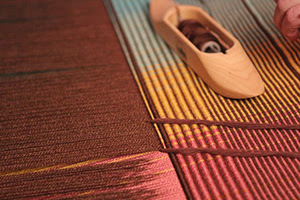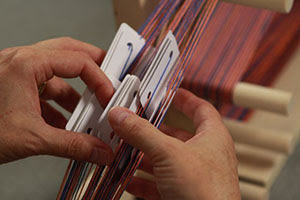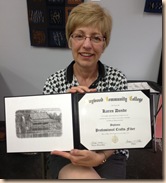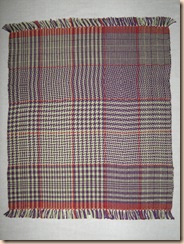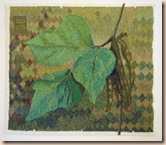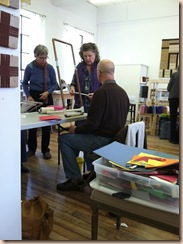I do little dyeing, printing, or surface design and have never knitted. Spinning doesn’t speak to me, and I only crochet when I chain a long warp. I have always sewn, but now only when I have to finish a piece for sale or a special event. What I do is design woven textiles, weave, and teach others to do the same.
| |  |
| | Susan Stowell fits Karen in the
muslin for the Roman’s Holiday suit.
Photo by Bob Morris. |
So when the opportunity came this year to participate in a juried fashion show emphasizing local resources and collaboration with other textile artists, I jumped at the chance to work with someone who could turn my handwoven cloth into a runway-worthy look. Project Handmade 2012 debuted last night in the modern, sophisticated atrium lobby of the Asheville Art Museum. It was a rousing success, but more on that later.
Early in this process, I was introduced to Susan Stowell, an Asheville couture seamstress and fashion designer. We met in May to look at my Alpaca and Friends yardage, which would soon be on its way to exhibit at Convergence 2012. Because the yardage incorporated custom-spun alpaca from a local farm, it was a perfect fit for this show, except that it waseighteen inches wide and four yards long.
We discussed options and decided to think on it a while. I was unsure about Susan’s initial suggestions, but liked her style and reputation for custom fitting. She was wondering how she was possibly going to match the distinct woven pattern, given the limited fabric dimensions. I, frankly, was a bit relieved the yardage would spend the summer in Long Beach, California, before Susan would take her shears to it. It is one thing to work up the courage to cut your own woven cloth, but to hand it over to someone who doesn’t weave and primarily works with commercial fabric is a serious gut-check.
It was at this point I was reminded of a line spoken by Michael Douglas in The American President. He was talking about democracy, but I think it works here: “Collaboration is hard, folks. It’s advanced communications, and you’ve got to want it.”
 | |
Karen and Susan’s handwoven suit,
modeled by Bearta Graff on the
Project Handmade 2012 runway.
Photo by Jeff Bullock.
| |
But, oh, when it works! In the end we agreed on a Chanel-inspired suit. The exhibit yardage would go into a jacket, and I was to weave coordinating yardage for the skirt. Looking around for appropriate yarn, I spied the soft golden-hued 30/2 muga silk I purchased in the Vendor Hall at Convergence. The color was perfect with the white cotton and Tencel warp I still had on the loom from a school project, and if I mixed in occasional stripes of a thicker tussah silk I had on hand, there would be enough of the expensive muga. Plus, the twill block threading could be treadled to create a small, subtle pattern to work with the bolder jacket pattern.
After wet-finishing three yards of 36-inch wide cloth, it looked and felt wonderful and coordinated perfectly with the other yardage. Off to Susan’s I went and proudly draped both fabrics across her cutting table. First words out of her mouth: “Horizontal stripes . . . for a skirt. Hmmm.”
To be fair, she agreed it was beautiful and that the two fabrics worked great together. “How about railroading it?” I suggested, a little apologetically. She said maybe and then told me not to worry. She was up for the challenge. Was she ever!
Our suit, named Roman’s Holiday after the local alpaca that gave his fleece for the yarn, was the first look down the runway at Project Handmade last night. Susan had volunteered to be a dresser, so was in the model changing room and didn’t see it walk. I was standing at the end of the runway in the packed museum atrium and was beaming.
| |  |
| |
Karen’s collaborator Susan Stowell
relaxing with Bearta after the show.
Photo by Karen Donde.
|
Thirty-six other looks followed, all with fabric created through weaving, felting, dyeing, printing, knitting, rubber/acrylic sculpture, or repurposing by artists working within a 100-mile radius of Asheville, which is what the sponsoring organization, Local Cloth, Inc., considers its fibershed. Other collaborations teamed more weavers, shibori dyers, and surface designers with fashion designers and sewers, using some fibers that were raised within our fibershed, processed and spun by a local yarn mill, or custom woven by a small local jacquard and dobby textile mill.
As impressive as was the collaboration required to create the looks, the collaboration required by the planning committee and other partners and volunteers to pull this off was even more so. As anyone who has ever organized a fashion show knows, the details are almost overwhelming: stage building, lighting, sound systems, music, photography, videography, models, hair and make-up, choreography, rehearsals, publicity, programs, ticket sales, refreshments, sponsor recruitment, grant applications, website, jurying, and meeting after meeting after meeting. How proud I am to have worked with five of the most creative, dedicated, energetic, “get-it-done” women I have ever met to make Project Handmade 2012 happen.
Certainly such collaboration is nothing new among weavers and other fiber artists who volunteer to produce fashion shows, international and regional conferences, exhibits, guild sales, or workshops in many parts of the world. Even collaborations that bring different textile design and production skills together to create a finished product for a show or for sale aren’t new, though they might be a bit rarer, given fiber artists’ tendency toward working alone.
I am reminded of the Convergence Designers’ Fashion Challenges of recent years, and of two stories I happened across in the September/October 1997 and November/December 1997 issues of Handwoven that featured collaboration between dressmaker Helen Saunders and weaver Yvonne Stahl to produce garments embellished with bindings, piping, cord, and tubes.
I’ll have to show those to Susan for our next collaboration.
–– Karen
|

